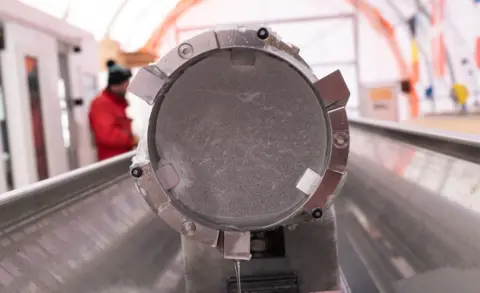In a groundbreaking scientific endeavor, researchers have successfully transported an ice core that might be over 1.5 million years old to the United Kingdom. This ancient ice is expected to provide critical insights into Earth’s climate history, enabling scientists to explore long-standing mysteries regarding climate change and atmospheric conditions from a time when the planet was markedly different.
The ice core, a remarkable example of preserved history, was extracted from deep within the Antarctic ice sheet. Its crystalline structure encapsulates thousands of years’ worth of information that could potentially reshape our understanding of changing climate patterns. As scientists prepare to melt this ice core, they anticipate uncovering valuable data regarding atmospheric gases, temperatures, and environmental conditions over an unprecedented timescale.
Dr. Liz Thomas, the head of ice core research at the British Antarctic Survey, emphasized the uniqueness of this project, stating, “This is a completely unknown period of our Earth’s history.” Currently stored in a -23C freezer at the British Antarctic Survey in Cambridge, this ice represents both a significant scientific opportunity and a logistical feat, as the transportation of such delicate samples required months of careful planning and execution.
Visitors to the British Antarctic Survey’s cold storage facility witness a scene of both wonder and precision, with carefully stacked boxes containing ice cores. Upon entering the freezer, researchers are reminded of the icy atmosphere; the ambient temperature is so low that cameras can freeze, shutter mechanisms can seize, and even hair can seem to stand on end due to static electricity. The ice cores themselves are remarkably clear, allowing observers to see through them, a testament to their frozen preservation.
Throughout the next seven weeks, scientists will proceed to melt the ice slowly, releasing ancient dust, volcanic ash, and microorganisms, including tiny marine diatoms encased within. By analyzing this material, researchers are set to glean information about past climatic influences, such as wind patterns and sea levels over the last 1.5 million years.
The significance of this research extends beyond mere historical curiosity. By understanding these ancient environmental indicators, scientists hope to draw parallels with current climatic changes affected by human activities. The ice core’s isotopes will provide vital clues regarding temperature fluctuations, rainfall amounts, and strong environmental shifts during epochs of significant greenhouse gas concentration.
This project is a result of international collaboration, with drilling operations conducted near the Italian-French Concordia research station in Antarctica, which is approximately 40 kilometers from the extraction site. Scientist James Veal, who participated in the drilling, described the feelings of holding such ancient ice. His role, along with countless others involved in this multinational expedition, has signified a substantial investment in time and funding, all amounting to millions to ensure the successful collection and transportation of these valuable samples.
In addition to analyzing the revealed materials, the research team must also investigate changing sea levels during significant climatic transitions, namely the Mid-Pleistocene Transition. It is a period of geological history that transitioned glacial cycles from 41,000 years to a staggering 100,000 years.
This research carries weighty implications for future climate understanding. Current carbon dioxide levels are notably higher than those recorded for the past 800,000 years, raising concerns about the trajectory of global temperatures. As scientists sift through evidence of historical climatic events, they hope to extract knowledge about Earth’s past behaviors that could inform expectations about future climactic shifts.
Ultimately, the commitment and determination of the teams involved are set against a backdrop of pressing climate issues, underscoring the need for a deeper comprehension of our environmental history as humanity faces unprecedented changes in our climate landscape. The melted ice could illuminate how these vast shifts occur and prepare us better for the future.











